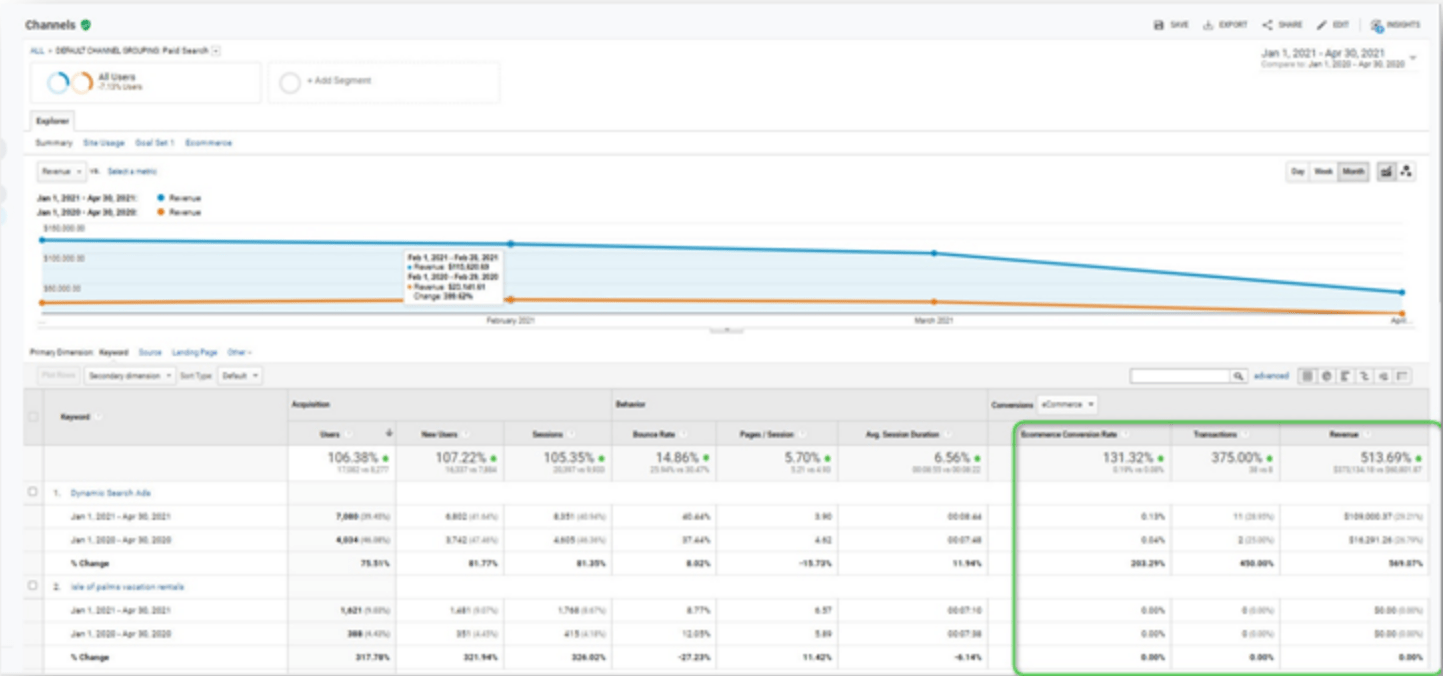There is no golden ticket to increasing your return on ad spend (ROAS), but one key thing to remember with pay-per-click (PPC) optimization and targeting is that Bid Adjustments are all-important. Your bid increases across the dozens of targeting elements are multiplicative. Over time, PPC optimization will deliver significant gains in ROAS and revenue by showing ads to your most likely bookers.
In this post, we will guide you through several strategies that will help you increase your return on ad spend up to 20x, as well as a few things to keep in mind if you’re using a PPC expert.
Ensure You’re Targeting Specific Geographical Areas
Geographic targeting in Google Ads allows you to be precise with your ad dollars. However, it’s essential to use a layered approach to targeting and not exclude areas of the US where bookers are coming from. It might not seem intuitive to get bookings from across the country. Still, it’s surprisingly common, and inexperienced PPC users often miss out on revenue by having too tight a geographical target setting.
To start setting up your geographical targeting, use a US target as your first layer, but input a bid decrease of around 25%. Next, layer on a state-level targeting your state and the nearby feeder states for your market.
Google Analytics data on all-channel conversions by geographical area can also be helpful for new Ads accounts to export the top ten states and add them as targets with a 15% bid increase. The bottom ten states that are spending budget but not driving bookings still count them as targets, but this time input a 40% decrease on the bid. This way, you’ll show fewer impressions and pay lower CPCs for those in areas unlikely to book – and thus preserve budget for the best-potential areas.
Lastly, add radius-level targets at various distances and increase their bid adjustments if they perform well.
Get Targeted With Your Audiences
‘Audiences’ in google ads are subsets of the population searching your keywords. These can be simple demographics like age, gender, income, marital status, and kids in the household; they can also be broader categories like Luxury Travelers, Skiing Enthusiasts, or Beachbound Families. Some important notes here are that all audiences need to be added to the “observation” mode – not the restrictive “targeting” mode. This task has to be done manually and will take time to gather data – but after a few months, you’ll be able to input bid adjustments on certain groups. After a few months, you can review your performance by age and income to decide how to adjust your bids to show your ads to the most likely bookers.
Create Audiences for Remarketing and Negative Remarketing
First, what is remarketing? Remarketing is when someone visits your website but doesn’t convert, so you show them ads, later on, to try again to convert them.
Now how do you set up remarketing in Google Analytics? First, always add a few custom audiences in Google Analytics that reflect previous site visitors; these are then ported over the Google Ads. We have found success in having an audience for site visitors in the last three days, last seven days, and last 15-30 days are good options. This ensures that if a person was on-site browsing many offerings, then the next time they search any of our keywords, our ads and brand name will be top-of-page and top of mind.
Next, we have negative remarketing: negative remarketing lets you stop showing ads to some searchers if they have already completed a transaction/booking on the site. This could come in handy when you have someone who has already booked but, for example, is searching your site for check-in information; showing ads to this person would be a waste of ad spend when you could be showing ads to people who haven’t booked yet. Since we never want to block a user from seeing ads forever, we typically create lists for customers who’ve booked in the last 30-90 days, depending on the typical booking windows of the customer. One final note here, simple negative bid adjustments do not work for a technical reason, so it’s best to block the audience outright and then unblock them after that 30/60/90 day window as you see fit.
Ensure You’re Monitoring Your Competitors’ Spend And Strategy
Keeping an eye on your ad market share as it relates to rival companies is a great way to determine if your spending is sufficient. There are several metrics to watch, but the first is the overall Impression Share, which will tell you how often ads for your destination as well as rivals come up when searching for your targeted keywords. The sweet spot for Impression Share varies significantly from market to market and is dependent on the level of competition – aka how many other bidders there are for those keywords. Typically, Q4Launch recommends a 15 to 35% impression share to maximize ROAS. If yours is over 50%, you either need to broaden keywords and targeting, or you may want to consider trimming budgets. Impression share and spending levels should be tracked over time for changes; this will alert you when a rival significantly boosts or cuts spending and let you decide how to respond.
Don’t Forget To Set Seasonally Adjusted Budget
Spending the same budget every month is illogical for most large travel advertisers because it disregards consistent consumer booking patterns – which naturally rise and fall depending on season and offerings. For beach vacation rental customers, for example, we almost always see in the data that January is a huge time for summer bookings, thus needs much more budget support than a month like October. Matching booking potential for each month to the PPC spend is the most effective way to maximize revenue and ROAS.
Below is an example of how Q4Launch used seasonally adjusted budgets to increase return on ad spend:
Look Past the Total ROAS To Know What Campaigns And Keywords Are Driving Revenue
Reviewing programs for ROAS performance should start at the campaign level. As you notice changes in performance, shift budget among campaigns to fund the highest-performing elements.
Your next steps should be at the Ad Group level: individual Ad Groups for specific types of searches, like oceanfront houses, for example. Segmenting ad groups in the design of the PPC program is essential. The best-performing PPC campaign aligns three things:
- User search query
- Ad copy that is relevant to that search query
- Relevant landing pages
To have the best results, breaking out campaigns into many ad groups is the most helpful. It lets you easily tweak the copy to be relevant and control landing pages, so the user ends up in the right place on site. This improves user experience and can drive significant revenue.
Conduct A Keyword Level Analysis
The goal of conducting a keyword-level analysis is to identify wasteful keywords. For example, it is helpful to add a filter to the Ads Interface only to show keywords with less than one conversion or less than a certain ROAS level is also a good filter. Next, you’ll need to start sorting by highest-spending keywords that haven’t driven a booking – knowing this will let you pause the inefficient keywords. In general, longer and more specific keywords can deliver better value because their cost-per-click (CPCs) are cheaper.
Implement Negative Targeting Lists
Implementing negative targeting lists will help you trim the fat on your PPC campaign by eliminating ads from searches that either doesn’t yield conversions or have a very low ROAS. An excellent example of using negative targeting lists would be a search for an unrelated resort’s phone number. It is critical to reference this frequently and keep building out the negative list to eliminate wasted spending, thus increasing ROAS.
Take Advantage Of Dynamic Ads
Dynamic ads are new in Google and allow semi-automatic matching of a user’s search query to a relevant page on the website. These work particularly well for specific addresses or streets, neighborhoods, and many other specific searches. The biggest challenge with dynamic ads is determining what pages you allow to be auto-matched. Less-experienced PPC advertisers should only allow the homepage and perhaps one or two other pages, showing the hotel rooms page or the all-houses page in the case of Vacation Rentals. If you do allow matching to all pages, your entire budget will likely go toward blogs, info pages, and other non-booking-intent pages on the website.
If you’d like to learn more about how to increase your return on ad spend you can receive a copy of our recent 20 Minute Takeaway, How To Get A 20x Return On Ad Spend, here:

